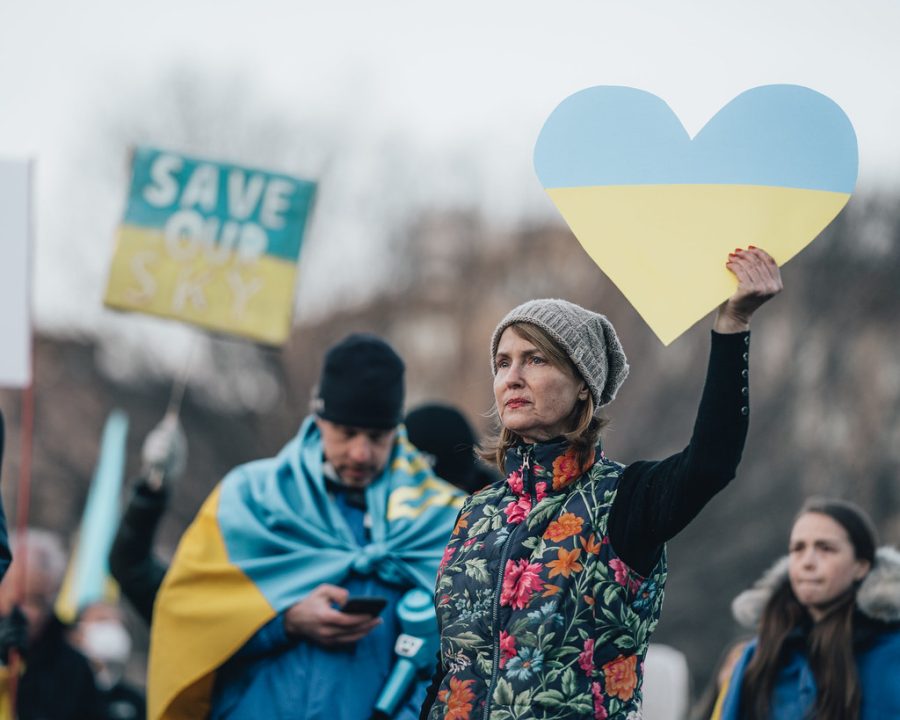Battling disinformation amid the war in Ukraine
March 17, 2022
Since Russia invaded Ukraine nearly three weeks ago, consumers are seemingly bombarded with disinformation of Russian advances across media platforms.
Some of the misinformation spread includes the Russian claim of the Ukrainian government killing Russian-language speakers.
Another popular urban legend involves a Ukrainian ace pilot known as the “Ghost of Kyiv.” But, unfortunately, these stories are lost in a sea of false narratives and stories meant to inject doubt.
For example, Daniil Bezsonov, an official for a pro-Russian separatist region in Donbas, tweeted a video of an explosion in an urban area claimed to be filmed in Kharkiv, but was, in reality, an arms depot explosion from 2017.
The Russian government has forbidden news outlets from describing the war in Ukraine as an invasion, executing a media crackdown on publications that deviate from the state stance and blocking access to sites like Facebook and the BBC for Russian citizens.
Russian state-affiliated outlets have also been spreading false theories on platforms like Telegram, TikTok and Twitter.
For example, according to a report from the magazine Foreign Policy, Ukraine is developing bioweapons “to prevent the American infectious disease expert Anthony Fauci from creating a sequel to the COVID-19 virus.” A fake fact-checking website, registered under the name “War on Fakes” has also seen a rise in popularity. Though claiming to debunk fake news on the invasion of Ukraine, the website uses Russian propaganda to provide information to be fact checked.
In a viral “War on Fakes” video, a man was recorded on Feb. 21, 2022 saying goodbye to his wife and child who had to flee Ukraine. This site falsely claimed that the family is no longer in danger, ignoring the fact that Russia invaded only three days later.
The website also falsely claimed that Russian forces are not carrying out missile, artillery or airstrikes in urban areas. The fraudulent fact-checkers fail to disclose their methods used to debunk “fakes.”
Russian state-affiliated media has also been endless in its attempts to obfuscate coverage of the invasion and portray Ukrainian forces as the aggressors.
For example, much of Russia’s state media has reported on an alleged improvised explosive device attack that produced multiple casualties and occurred in Donbas on the morning of Feb. 22.
But many media sources and observers have cast doubt on the details of the alleged incident, and researchers who have examined the details noted the bodies of the “casualties” were dead before any potential explosion.
As shown by the open-source outlet Bellingcat, the corpses had “clear cuts on both sides of the head, cleanly separating the skull cap from the rest of the skull” that were not consistent with trauma caused by an improvised explosive device.
The Russian government has been responsible for the vast majority of disinformation relating to the invasion of Ukraine and while the Ukrainian side has also had its share of disinformation, it has not reached a nationwide scale.
The video of the aforementioned “Ghost of Kyiv”, a supposed Ukrainian MiG-29 pilot credited for shooting down six Russian air force planes, was discovered to have been made in the video game “Digital Combat Simulator World.”
Fake photos of the “Ghost of Kyiv” have been widely circulated but are recognizable as counterfeit in a reverse image search. Though the existence of an ace pilot cannot yet be confirmed, it is recognized that most of the documentation of the alleged pilot are forgeries.
Although the Ukrainian government has not officially promoted the existence of the “Ghost of Kyiv,” it appears to tolerate the spread of the legend to likely help keep Ukrainian morale high.
Some accounts on social media have also spread old photos and videos without context and passed them off as Ukrainians resisting the Russian invasion.
Despite the misinformation, one can remain informed with the correct news stories. When verifying sources, it is best to get information from credible news sources and to read before sharing. It is also important to verify a site’s URL to check if it is legitimate or a spoof.
Reverse image searching can help users verify and identify the source of photos in the conflict, making it easier to discern fake from real and new from old.
It is also advised to treat claims without a verifiable source with skepticism and cross-reference such claims from reputable news outlets.
There has been an outpour of scammers asking for donations to help war efforts. All media consumers should search online to verify where the donations are going.
Through savvy fact-checking and cross referencing, one can fight the battle against misinformation.







